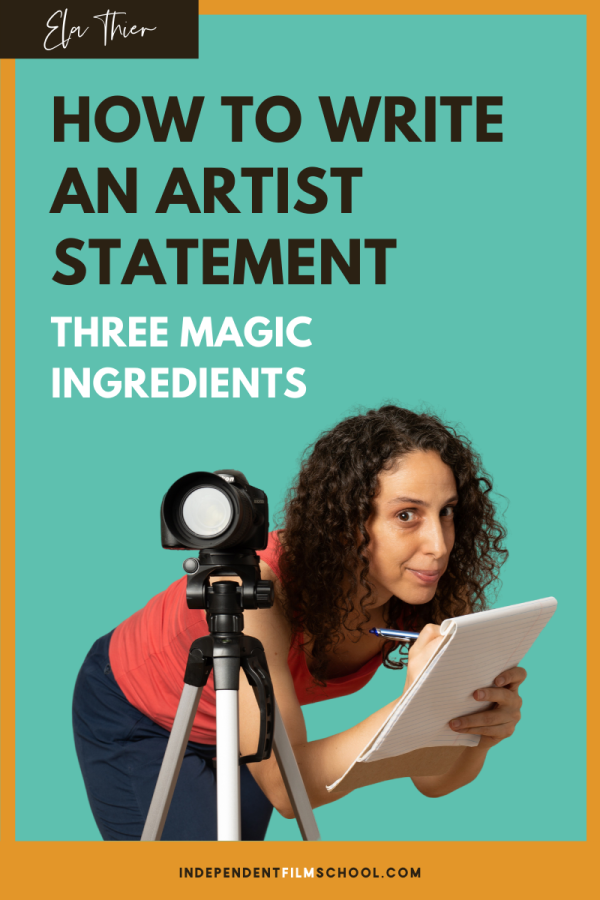
Ever balk at the task of having to write an artist statement?
Something I didn’t learn in film school is how to write an artist statement, and it’s something I’ve had to do a billion times (or so it’s felt). Before I get into my three magic tips that will help ease your process and arrive at your strongest possible statements, let me cover the basics in case you’re not familiar:
What’s an artist statement?
An artist statement is the creative, personal touch that you add to presentation materials that describe your project. For example, you may create a PDF with a short synopsis of the story, your bio, and then an artist statement where you speak more personally about your work.
When do you need to write an artist statement?
Grants, pitch decks, business plans, formal offers, one-sheets, contests, festivals, ugh. Why is everyone so obsessed with giving us homework assignments? I don’t know. But all of the above usually require it, or give you the option to add one.
When the option is there to add one, I recommend doing that. A strong artist statement can make or break an application.
Other times, it may be entirely up to you what goes into your presentation material. For example, you may be creating a business plan to approach investors, or what’s called a “one-sheet” (a single sheet that describes your project), in order to send a formal offer to an actor or query a producer. In those situations, it’s up to you what goes in there.
I recommend adding an artist statement in those materials. It will feel the reader more connected to you personally, and it’s an opportunity to communicate why the work matters. More on that below!
What goes into an artist statement?
It’s mostly up to you what goes in there. But not unusual to add things like:
Why you’re creating it.
Why it matters (what impact you think it could have, or why it’s important to you personally).
Why you’re exactly the right person to create this particular project.
The original inspiration: You might add a personal story about how the project came to be.
These statements usually range between 100 to 500 words, and shorter is usually better.
So that’s the what. Let’s get to the how!
Tip ONE – Spend 5% of your time writing, and 95% of your time tweaking what you wrote.
We get stuck writing artist statements because the stakes feel high. If it’s not amazing you won’t get that grant, investment, this person involved, whatever.
Nobody can write from that space.
Set a timer to 10 minutes, and then don’t stop putting words on the page till the timer goes off. (See my video on freewriting in my article on ending writing blocks in 10 minutes.)
Write badly. Overwrite. Meander into irrelevant stuff. The room is hot. The fridge is empty. Whatever. Put. words. on. the. page. Don’t stop till the timer goes off.
After 10 minutes, consider doing another 10. Do this 10-minute freewrite thing 3 times. Or if you have it in you, do 30 minutes in one fell swoop. But no cheating. This can’t be 30 minutes of scratching your chin and thinking about what to write. It’s a brain dump.
Once you’ve done 30 minutes (tops!) sit back and dig through that pile of overwritten garbage to find all the diamonds and pick them out.
If you like dumpster diving, you’re gonna love writing artist statements.
Mark those sentences, ideas, paragraphs that actually say something interesting.
Five to ten percent of the work in writing an artist statement is freewriting a whole bunch of garbage.
Ninety to ninety-five of the work is dwindling it down to its essentials and getting it super tight and concise (fun!)
I love those annoying applications where you have to submit a statement that’s no more than 100 words, 500 words, 60 words, or whatever word count they put in there. (Who creates these applications? Do they not know that artists do their creative work while holding a job and have no time for this? Artists should get paid for the time we put into these applications. But I digress…)
You can actually get zenned out having to hack at it until you get the statement down to the exact word count. Fun!
Tip two – Don’t write smart. Write the way you talk.
When you write the way you talk and you become unimaginably powerful. For real. If you can be yourself on the page, you become irresistible to your reader.
Sound like a college text book talking about “cinematic language” or whatever, and you’ll put your reader to sleep.
Write the way you talk to your friends, and your reader will feel like they just made a new friend. They’ll want more of you. If it’s a really formal thingy, take out the f-bombs or whatever later, but maybe leave in the word thingy…? 😉
Tip three – Write a statement about yourself, not about your work.
I swear, whatever project I pitch, I’m always writing the same artist statement. Why? Because I have a mission statement – a personal mission statement. And I’d like to encourage you to have one too.
clarify your overall mission statement as an artist. then explain how the particular work serves that larger vision.
In other words: I’m letting my reader know that I’m not seeking their support in creating a particular piece. They would be supporting a lifetime of work that is dedicated to a single mission. By supporting a given work, they’re propelling forward an entire machinery that’s moving towards its one, single goal.
If you’re not sure what your mission statement as an artist is, feel free to steal mine and write your own version of it.
At the end of the day, I believe that we’re all aiming for the same thing. We all want to have positive impact in this world of ours, and we’re trying to figure out how to do that. Here goes:
My personal mission statement in exactly 60 words:
I use teaching and entertainment to transition our societies from being governed by greed to being governed by human caring. My films heal by getting people to laugh and cry. They’re my reminders that there are no bad people, only hurt people. I’m building a movement of filmmakers who are joined together in their own versions of this mission statement.
